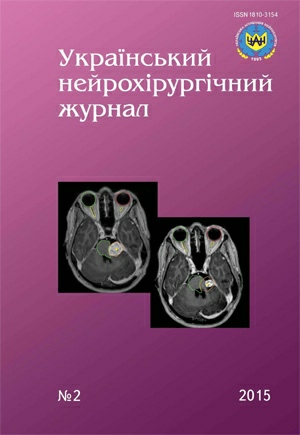Phenotypical changes and proliferative potential of mesenchymal stem cells from humans Wharton’s jelly in the cultivation conditions
DOI:
https://doi.org/10.25305/unj.45290Keywords:
mesenchymal stem cells, human umbilical cord, cultivation, proliferative potentialAbstract
Purpose. To develop a protocol for mesenchymal stem cells (MSCs) obtaining from wharton’s jelly of human umbilical cord, to study their phenotypic changes and proliferative potential in culture.
Materials and methods. MSCs from human umbilical cord were cultured for 6 passages. To study morphological features of the cells in a culture we used adapted staining with eosin and gematoksilіn, Romanovsky–Giemsa, and toluidine blue. For nuclear DNA coloring we used intercalators: Hoechst 33342, and DARІ Ethidiumbromid. MSCs surface markers (CD105, CD90, CD73, CD34) expression was studied by FACS-analysis.
Results. In the culture MSCs retain their morphological identity for 2 passages. Further a tendency to MSCs markers expression decreasing was observed, signs of culture degradation, spontaneous chondrogenic and adipogenic differentiation in late passages.
Conclusion. Cultured MSCs of human umbilical cord for 2 passages retain their morphological characteristics and proliferative potential, further they lose multipotent mesenchymal phenotype.
References
Augello A, Kurth T, De Bari C. Mesenchymal stem cells: a perspective from in vitro cultures to in vivo migration and niche. Eur Cell Mater. 2015;(20):121–133. [Publisher Full Text]
Bieback K, Brinkmann I. Mesenchymal stromal cells from human perinatal tissues: From biology to cell therapy. WJSC. 2010;2(4):81-92. CrossRef
Wang Z, Li Y, Ahmad A, Azmi A, Kong D, Banerjee S, Sarkar F. Targeting miRNAs involved in cancer stem cell and EMT regulation: An emerging concept in overcoming drug resistance. Drug Resistance Updates. 2010;13(4-5):109-118. CrossRef
Thiery J, Acloque H, Huang R, Nieto M. Epithelial-Mesenchymal Transitions in Development and Disease. Cell. 2009;139(5):871-890. CrossRef
Semenova VM, Lisianiy MI, Stayno LP, Belska LM, Yegorova DМ. [Proliferative and differentiated potential of mesenchymal stem cells from adipose tissue under cultivation conditions]. Ukrainian Neurosurgical Journal. 2014;(3):24–29. Russian. [Abstract/Full Text]
Selezneva T, Mishyn A, Barsukow V. Gistologiya. Polnyi Kurs Za Tri Dnya. Moscow: Eksmo; 2007. Russian.
Kalluri R. EMT: When epithelial cells decide to become mesenchymal-like cells. Journal of Clinical Investigation. 2009;119(6):1417-1419. CrossRef
Kalluri R, Zeisberg M. Fibroblasts in cancer. Nat Rev Cancer. 2006;6(5):392-401. CrossRef
Patel A, Park E, Kuzman M, Benetti F, Silva F, Allickson J. Multipotent Menstrual Blood Stromal Stem Cells: Isolation, Characterization, and Differentiation. cell transplant. 2008;17(3):303-311. CrossRef
Huang G, Gronthos S, Shi S. Mesenchymal Stem Cells Derived from Dental Tissues vs. Those from Other Sources: Their Biology and Role in Regenerative Medicine. Journal of Dental Research. 2009;88(9):792-806. CrossRef
Taghizadeh R, Cetrulo K, Cetrulo C. Wharton’s Jelly stem cells: Future clinical applications. Placenta. 2011;32:S311-S315. CrossRef
Maslova OO, Shuvalova NS, Sukhorada OM, Deryabina OG, Makarenko MV. Changes in morphofunctional characteristics of umbilical cord matrix mesenchimal cell вuring passaging. Problems of cryobiology. 2012;22(2):153–156. Available at: http://www.researchgate.net/publication/235248761_Changes_in_Morphofunctional_Characteristicsof_Umbilical_Cord_Matrix_Mesenchymal_Cells_During_Passaging. Accessed September 15, 2014.
Kozlovskaya LV, Nikolayev AYu. Uchebnoye posobiye po klinicheskim laboratornym metodam issledovaniya. Moscow: Meditsina, 1984. Russian.
Gimble J, Guilak F, Nuttall M, Sathishkumar S, Vidal M, Bunnell B. In vitro Differentiation Potential of Mesenchymal Stem Cells. Transfusion Medicine and Hemotherapy. 2008;35(3):228-238. CrossRef
Jennings B, Ridler P. Interaction of chromosomal stains with DNA. Biophys Struct Mechanism. 1983;10(1-2):71-79. CrossRef
Baraldi PG, Bovero A, Fruttarolo F, Preti D, Tabrizi MA, Pavani MG, Romagnoli R. DNA minor groove binders as potential antitumor and antimicrobial agents. Medicinal Research Reviews. 2004;24(4):475-528. CrossRef
Gray J, Darzynkiewicz Z. Techniques In Cell Cycle Analysis. Clifton, N.J.: Humana Press; 1987.
Kubista M, Aakerman B, Norden B. Characterization of interaction between DNA and 4',6-diamidino-2-phenylindole by optical spectroscopy. Biochemistry. 1987;26(14):4545-4553. CrossRef
Wexler S, Donaldson C, Denning-Kendall P, Rice C, Bradley B, Hows J. Adult bone marrow is a rich source of human mesenchymal 'stem' cells but umbilical cord and mobilized adult blood are not. British Journal of Haematology. 2003;121(2):368-374. CrossRef
Downloads
Published
How to Cite
Issue
Section
License
Copyright (c) 2015 Vitaliy Tsymbaliuk, Elena Deriabina, Nadezhda Shuvalova, Olga Maslova, Ianina Pokholenko, Olena Toporova, Svitlana Shpileva, Vitaliy Kirik, Leonid Pichkur, Iuriy Kasianenko, Oleksandr Pichkur, Vitaliy Kordium

This work is licensed under a Creative Commons Attribution 4.0 International License.
Ukrainian Neurosurgical Journal abides by the CREATIVE COMMONS copyright rights and permissions for open access journals.
Authors, who are published in this Journal, agree to the following conditions:
1. The authors reserve the right to authorship of the work and pass the first publication right of this work to the Journal under the terms of Creative Commons Attribution License, which allows others to freely distribute the published research with the obligatory reference to the authors of the original work and the first publication of the work in this Journal.
2. The authors have the right to conclude separate supplement agreements that relate to non-exclusive work distribution in the form of which it has been published by the Journal (for example, to upload the work to the online storage of the Journal or publish it as part of a monograph), provided that the reference to the first publication of the work in this Journal is included.









